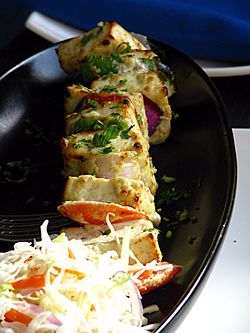Tikka (food) facts for kids

Paneer Tikka served in a restaurant in Mumbai, India.
|
|
| Course | Hors d'oeuvre |
|---|---|
| Region or state | Indian Subcontinent |
| Serving temperature | Hot |
| Main ingredients | Meat, paneer, marinade, yogurt, spices or curry |
| Variations | Chicken Tikka Masala, Paneer Tikka Masala |
Tikka is a tasty dish made from small pieces of meat or vegetarian options like paneer (a type of cheese). This food comes from the Mughal dynasty in India. To make it, the pieces are soaked in a special mix of spices and yogurt. Then, they are cooked in a very hot oven called a tandoor. Tikka is very popular in places like Great Britain and all over the Indian subcontinent.
You might have heard of Chicken Tikka Masala, but Tikka is a bit different.
Contents
What Does the Word "Tikka" Mean?
The word Tikka comes from the Punjabi language. It means "piece" or "chunk." It's related to the old Turkic word tikkü. When you hear "Chicken Tikka Masala," the "masala" part is an Urdu word, and the whole name became popular in the UK.
Where Did Tikka Come From?
No one knows the exact start of Tikka. But, people have been cooking spiced meat in sauces for a very long time! Recipes for similar dishes were found on ancient tablets from around 1700 BCE, near Babylon.
Later, during the time of the Mughal rulers in India, they brought a dish called Tikka with them. These were "boneless pieces of cooked meat." Today, Tikka means small pieces of meat or vegetables that have been soaked in a spicy mix.
How Is Tikka Made?
To make Tikka, you start with small, boneless pieces of meat or vegetarian choices like paneer. These pieces are soaked in a marinade made of spices and yogurt. This soaking makes them very flavorful.
After marinating, the pieces are put onto a skewer (a long stick). Then, they are cooked in a tandoor, which is a special clay oven. Tikka is usually served dry, meaning without a lot of sauce.
Different Kinds of Tikka Dishes
Tikka in India and Nearby Countries
The original types of Tikka come from the Indian subcontinent. Simple dishes like Chicken tikka and Paneer tikka are often served dry. These are the basic forms of Tikka. Over time, new versions like Chicken tikka masala became popular in other countries, like Britain. Now, these new versions are also found in restaurants across the Indian subcontinent.
Tikka Mixed with Other Cuisines
Sometimes, Tikka is mixed with foods from other cultures. For example, you can find Tikka Masala Burritos. These are a mix of Indian Tikka and Mexican burritos, often with chicken or paneer inside.
How Popular Is Tikka?
Tikka's Popularity in Britain
In the 1990s, a study in Britain showed that people there really liked foreign foods. Chicken tikka was a favorite filling for sandwiches sold on British trains!
Tikka's Popularity in India
A study at Indira Gandhi International Airport in New Delhi looked at what street food foreign tourists liked most. Chicken tikka was the top choice! Tourists liked foods that were not too spicy and were made cleanly.
During the cricket World Cup in 2018, restaurants in the host city even named Tikka dishes after famous cricket players. For example, Paneer tikka was called Dhoni da Tikka, after the former Indian cricket captain. Chicken tikka was named Virat's Straight Drive, after the current captain.
Keeping Tikka Fresh and Tasty
Keeping Paneer Tikka Fresh
Paneer tikka usually stays fresh for only 1 to 2 days. But, if you use special vacuum packaging, it can stay fresh in the refrigerator for up to 40 days! This special packaging helps keep it from changing chemically.
Improving Chicken Tikka Quality
You can make chicken tikka even better by using a marinade with lemon juice and ginger extract. This marinade also helps lower the fat and cholesterol in the chicken. It makes the chicken taste better, feel juicier, and have a better texture. Another method called vacuum tumbling can also improve how chicken tikka looks, its color, texture, and juiciness.

